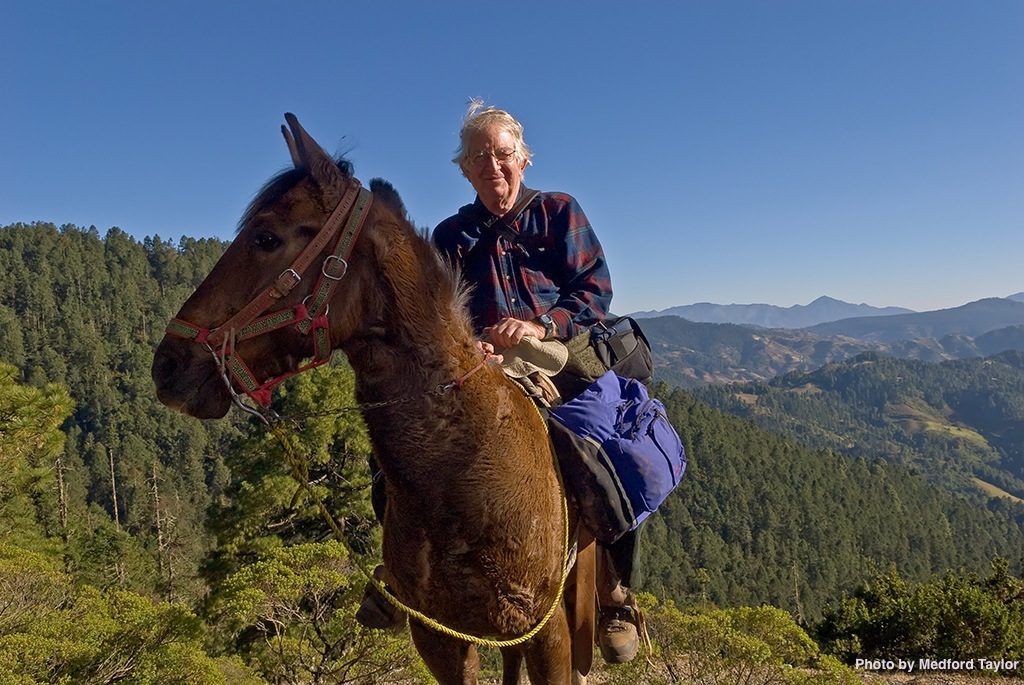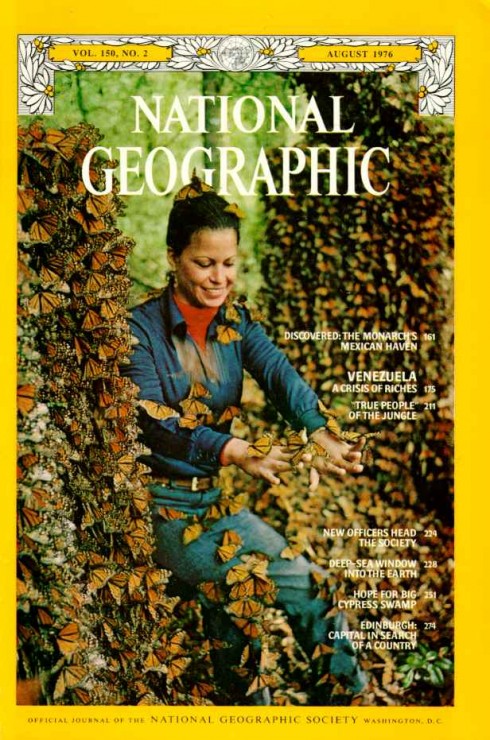
Dr. Lincoln Brower–photo via Monarch Butterfly Fund
At 83, Dr. Lincoln P. Brower has studied Monarch butterflies longer than anyone on the planet. He first became enamored of butterflies as a five-year-old in New Jersey and later by Monarchs when he learned they don’t taste good to predators. His famous “Barfing Bluejay” photo, below, proved their unpleasant taste to predators and always gets a chuckle when I share it in presentations.
Brower followed his passion and turned his attention to Monarch biology as a grad student at Yale in 1954. He has visited the roosting sites in Mexico more than 50 times since his first trip in 1977–15 years BEFORE Dr. Chip Taylor, the other grandpa of the Monarch community, started the citizen scientist Monarch butterfly tagging program, Monarch Watch, in 1992.
So it’s no surprise that after a lifetime invested in the dramatic orange-and-black butterflies, Brower takes Monarchs personally. When he recently lent his name to the petition to list the Monarch butterfly as “threatened” under the Endangered Species Act (ESA), few people were surprised. NOTE: The period to join 306 others who have commented on the petition closes March 1, 2015.

Dr. Brower’s famous “Barfing Bluejay” photo of a bird wretching after eating Monarchs, proved Monarchs don’t taste good. Photo courtesy Dr. Lincoln Brower
Dr. Brower graced the Texas Butterfly Ranch with a visit back in October of 2011 when he toured the Texas Hill Country during the peak of the historic Texas drought.
The man is amazing. Tromping across the limestone watershed, butterfly net in hand, we tagged dozens of butterflies that day for a study he was doing. Between net swoops, Brower taught me how to identify male from female Monarchs without having to open up their wings, a trick I still use today.
Brower can be a purist. He’s said that Tropical milkweed, Asclepias curassavica, should only be planted in a laboratory or controlled environment because it might spread disease in Monarchs–a directive he recently amended. Now he advises the Monarchs’ favorite host plant be planted no further north than Orlando, Florida. Brower also called the recent 70% increase in Monarch numbers “catastrophic.”
“That change is trivial,” said Brower. “We were thinking it would be more than two hectares. What we need is up to five hectares.”

Monarch Butterfly Dream Team: Kip Kiphart, Jenny Singleton, Dr. Lincoln Brower, Monika Maeckle, Mike Quinn
Since the petition was submitted, much attention has been focused on our favorite migrating insects, who’s “canary in the corn field” status makes them pollinator decline’s apt and timely poster child. Climate change, overzealous pesticide use, genetically modified crops and general human domination of the planet all play their role in challenging Monarch butterflies and the entire food web.
Awareness of these critical issues is fundamental to addressing them and the ESA petition has raised unprecedented awareness. Some of us may disagree that ESA status for Monarchs is the best tool for the job, but it’s impossible to not recognize how the petition has served to raise the profile of Monarch butterfly and pollinator decline. So thanks to Brower and the petitioners for creating needed drama.
We recently chatted with Dr. Brower, who currently serves as Distinguished Service Professor of Zoology Emeritus at the University of Florida and Research Professor of Biology at Sweet Briar College. The conversation migrated from email to phone and back. Here, in his words, is how he sees the current landscape.

Dr. Lincoln P. Brower at Sierra Chincua in 2007, one of more than 50 trips he’s made to the roosting sites. Photo by Medford Taylor, courtesy Dr. Lincoln Brower
Q. Recent events, including your participation in filing a petition to list the Monarch butterfly as “threatened” under the Endangered Species Act, have brought unprecedented attention to the decline of the Monarch butterfly migration. Was this the honest intent of filing the petition–to bring attention to the situation rather than actually list it? Or do you still believe that listing the insect as endangered is the appropriate approach to conservation?
Brower: Those involved in writing the petition had, I think, two goals: One, to raise public and government awareness; and two, to generate funding of varied mitigation programs, private and public.
.
Q. Do you still believe that listing the Monarch butterfly is the best option or have you changed your mind?
Brower: I did when I signed onto the petition and the evidence I have seen so far seems to be supporting that contention. I think we will have to wait and see what happens. It is possible that nothing we can do will preserve the Monarch’s migration and overwintering biology spectacle.

Citizen scientists like Catalina Trail were instrumental in pieceing together the mysteries of the Monarch butterfly migration.
Q. If the Monarch becomes listed as threatened under the Endangered Species Act and milkweed and physical contact with Monarch butterflies will likely be controlled, do you share concerns about the disenfranchisement of the citizen scientists and Monarch butterfly enthusiasts that have for decades been instrumental in unraveling the mystery of their migration?
Brower: Appendix B page 162 of the petition is worded in confusing legalese but states that citizen scientists’ participation and conservation efforts will not be restricted. I have recommended that the stated limit of ten butterflies per person be raised to 100.
Q. Recent studies link Tropical milkweed, Asclepias curassavica, to increases of OE in Monarchs. If other species of milkweed–Swamp or Common, for example–had been the species widely cultivated and made available commercially to gardeners, would we be having the same issues with those plants?
Brower: Curassavica likely would not normally have entered Texas from Mexico in the past or future even with global warming. It does not tolerate desert conditions in its natural geographic distribution. As I have stated elsewhere, I think it is a mistake to plant it north of the City of Orlando, Florida latitude in the U.S.
The recent paper by Satterfiled, et al, is relevant. Propagation of locally occurring native milkweeds and planting them widely in gardens along roads, etc., is what should be done. The Monarch community needs to jump on this bandwagon and influence plant nurseries to do this for their sales. Bring everyone together to do the best we can to increase native milkweed habitat.

Tropical milkweed is technically not native but the most widely available species of Monarch host plant. Native milkweeds are best.
Q. Is it at all arrogant of us, the human species, to insist that the Monarch migration continue as climate change, human impacts and other factors conspire to make it possible for Monarch butterflies to continue their life cycles and reproduce without migrating 3,000 miles? And if the need to migrate changes or no longer exists, who are we to say that it should continue? (I wonder what a Monarch butterfly would say if we gave them a choice of migrating or not?)
Brower: As we discussed at length, these are ethical questions. Should we try and preserve natural phenomena such as the Monarch migration? Analogously, should we try and save pandas, polar bears, endangered plants. etc.
Turn the question around: is it ethical to let these things go extinct when we have the ability to prevent that from happening? Are people the only creatures with a right to rich and natural lives on this planet?
You know my answer, it is dead wrong not to try to prevent loss of natural species and what they do from bacteria to humans. If rabies were to take over, the view of letting it be would mean the end of dogs. How can anyone even think that is tolerable. I feel the same way about the Monarch…In addition, preserving it is symbolically important: it is the “canary in the corn field” telling us something very broad and serious is wrong with managing our planet.
Q: Dr. Brower, I agree with you regarding species going extinct, however we are talking about the migration. Few folks believe the Monarch butterfly will become extinct. Do you make a distinction that some behaviors outlive their usefulness–such as, perhaps, the Monarch migration?
Brower: My colleagues and I have referred to the Monarch migration/overwintering behavior as an endangered biological phenomenon. My thesis above also applies exactly to this category of biodiversity.
Should we work to restore the bison migrations or just keep them in a few zoos and confined pastures? What about the bamboo forests of China: let them and the panda inhabitants be destroyed while keeping a few panda breeding programs going to make sure zoos are profitable? Bioethics again.
Related posts:
- Survey: Monarch Butterfly Enthusiasts will Pay More for Clean, Native Milkweeds
- Monarch Tagged With Lincoln Brower on Llano River Recovered at El Rosario
- MIlkweed Guide for Central and South Texas
- Assessing Drought, Chasing Monarchs on the Llano with Dr. Lincoln Brower
- Monarch Butterfly News Spurs EXTREME Interest in Native Milkweeds
- Endangered Species Act Wrong Tool for the Job of Monarch Butterfly Conservation?
- Monarch Butterfly Inches Toward “Threatened” Status Under Endangered Species Act
- How to Get Native Milkweed Seeds to Germinate
- Monsanto: Absolutely committed to Monarch Butterfly Conservation
- Native American Seed and the Challenges of Persnickety Texas Native Milkweeds
- How to Raise Monarch Butterflies at Home, Part One
Like what you’re reading? Follow butterfly and native plant news at the Texas Butterfly Ranch. Sign up for email delivery, like us on Facebook, or follow us on Twitter, @monikam.


I have a class of 50 plus kids that want to start a butterfly garden in existing above ground planters any tips? We have some rosemary growing in some of the planters.
Hope you have been able to start a butterfly garden, I’m new here and I found this great page, I thought I would share. Happy Butterflying! http://www.joyfulbutterfly.com/what-do-caterpillars-eat/
Great questions, Monika. Some dodgy answers, I’m afraid. The buffalos won’t be migrating again any time soon for the same reasons, human action causing habitat destruction. Polar bears, pandas and endangered plants have limited habitats which we are destroying. Unfortunately, there is a difference between preserving natural species and “what they do.” What do you think, Monika?
Amen, we have an ethical call to action here, I’ve been saying it as loudly as I can, as Monika knows. Thank you, Lincoln, for calling out the ethical imperative and how it implicates us.
The monarch migration is not going extinct. The Monsanto farmlands of the upper Midwest are actually where one can film spectacular gatherings of monarchs like this one in late August and early September https://www.youtube.com/watch?v=32usE8vikxA Some GMO crop farmers are starting to post photos too of the monarch gatherings on their farms like this one did: https://www.learner.org/cgi-bin/jnorth/jn-query-byday?1409942868
I ‘ve enjoyed raising, and exhibiting monarchs for the enjoyment of children and adults alike as a wonderful hobby.
Unfortunately there are people who are pursuing financial and political gain on the back of the natural dip in monarch numbers at overwintering sites. Maybe it’s a justification for years spent. My scientist say Native milkweed in the Great State of Texas suffered unprecedented damage through the unprecedented drought between 2009-13 but it’s recovering. The 2015 increase in numbers prove it unless you know who planted the 50 million milkweed needed to increase the numbers overwintering 20 million. The silence on this topic by the “experts is deafening further proving this to be a fact. Furthermore, availability of native seeds and the bad mouthing of tropical “could” reduce numbers this year folks. Fortunately, with favorable weather conditions this year there should be twice as many leaves on existing recovering native milkweed plants to feed twice as many caterpillars and increase numbers considerably. When the most visible person in monarchy states a 70% increase in overwintering monarchs is catastrophic this tells us a lot about motives.
[…] Dr Lincoln Brower, studying the Monarch Butterfly since 1954 [ Texas Butterfly Ranch Q&A ] […]
Monika: Spouse and I have some former vacant land on LaChappelle, just south of S. Alamo and Flores (SouthTown). Would like to set aside a portion of it for Butterfly habitat. May we have your guidance?
Unable to use the entire couple of acres due to pressure from City periodically mow the property.
My hat is off to everyone involved. There is a new non-profit organization that people might want to check out: monarch city usa
It brings the awareness of habitat to the American cities by city signage. Like tree city usa. All hands on deck.
[…] here. In 2013, we had a most auspicious encounter with one of the leading Monarch scientists, Dr. Lincoln Brower, while visiting Monarch sanctuaries in Michoacán Mexico. That year, we were told, was the record […]
I’ve been teaching about Monarchs for almost 7 years to school age children in the first grade of our local public school system. To date I’ve had almost 30,000 students go through my program. Most of my knowledge comes from a variety of resources and I always claim that I am “No Monarch expert”.
I’m located in MD and order eggs/cats from PA (Closest I could get to local). I have to order b/c we distribute close to 1200-1500 caterpillars to classrooms (No way I can collect that many locally). We have built gardens (Milkweed and native nectar plants) at over 80 schools to help support and eventually self-sustain each school in regards to the demand for caterpillars and milkweed needed for the program.
I have many questions of my own, but one in particular that relates directly to our program of raising Monarchs in the classroom has challenged me for years.
My question is this:
What are we doing to the natural cycle of Monarchs and their migratory habits that are raised in a breeding program and distributed to classrooms to be raised indoors? If any make it to Mexico, will they instinctively know to return in the direction of Maryland upon migrating North? Is all of the Monarch breeding and raising that is occurring nationwide a good thing or are we causing more harm than good to the wild population? Have any studies been done to research whether wild Monarchs and Monarchs raised by people differentiate between each other or is a Monarch a Monarch?